Cat Showmanship
CAT SHOWMANSHIP
Acknowledgement: The information for this section is based on the Ohio State University 4-H Cat Showmanship Guidelines.
Showmanship is a competitive event and requires practice and learning to become skilled. Start working with your cat early.
As a 4-H member, it is important for you to:
- Have a cat that is appropriate for your abilities.
- Handle all aspects of the care and grooming of your cat.
- Participate in a year-round wellness program, keeping your cat vaccinated and free from internal and external parasites.
- Spay or neuter cats that are not purebred, and purebred cats that are not used for breeding purposes.
- Socialize your cat prior to bringing him or her to show.
- Accustom your cat to a harness and leash, cat carrier, and being transported in a vehicle.
- Put an identification tag on your cat’s harness in case he or she should be lost.
- Learn as much about cats as possible from your project book and other resources.
- Have fun with your cat!
Appearance and Conduct Count!
- You as well as your cat are on display the entire time you are in the show ring. Besides representing 4-H, you are presenting an image to the judge as well as the spectators.
- Your appearance and conduct are important.
Grooming Cats
- Cats should be well groom Claws must be trimmed, regardless of whether or not they are outdoor cats. Their coats must be free from mats and burs. Cats should not shed excessively. The eyes and nose must be free of discharge. The ears must not show any signs of mites or have any dirt in them. The teeth should be reasonably clean and free of tartar.
Showing Cats
Equipment:
Carrying Cage. Leash and harness.
Showing Procedures
NOTE: The judge may ask exhibitors to come the table one at a time or they may ask all exhibitors to bring their animal to the show table and line up all at once. You should be comfortable with both methods.
- Keep the harness and leash on your cat; loop the end of the leash over the wrist of one arm.
- Be aware of where the judge is; however, remain focused on your cat and not on the judge.
- Be able to take direction from the judge if called for.
- Be polite to those around you and to the judge.
- Keep your cat a safe distance from other cats to prevent a confrontation or fighting.
The judge will:
- Observe the relationship between you and your cat.
- Asses if the cat is responsive to you and your actions.
- See if you are keeping your cat under control.
- Assess if both you and your cat are relaxed.
- Try to determine if you were responsible for the majority of your cat’s care, completing the project with minimal help taking into consideration your age and abilities.
- Evaluate how well you answer the questions during your interview, and how well you and your cat complete the exercises.
Showmanship Steps
- When called, hold your cat in the safety carry and approach the judge or follow the judge’s or ring steward’s directions.
- Keep the end of the leash looped over your wrist.
- Set your cat on the table facing the judge either in a sitting or standing position.
- You will be asked approximately five questions about cat These questions should come from the cat project book you are taking, with consideration given for the number of years you have taken a cat project as well as your age.
- You should have general knowledge of 4-H, such as the pledge, motto, description of the emblem, etc.
- The judge will be assessing your cat’s general health and overall conditi They must appear healthy. They must not have any eye discharge, runny noses, dirty ears or ear mites, fleas or other external parasites, patchy fur, open sores, or other health problems.
- Cat must allow the judge to examine them without clawing, hissing, or growling. The judge will make 3 attempts to examine the cat before moving If a cat continues to exhibit a threatening temperament, he or she may be excused from judging for the safety of the exhibitors, other cats, and the judge.
Refer to all other General Showmanship Guidelines on pages 1-3 and your county or show rules.
PRESENTING YOUR CAT FOR EXAMINATION
You, as the exhibitor, will be asked to show the judge how to:
- Properly pick up a cat
- Hold the cat in the safety carry position
- Open your cat’s mouth to show his/her teeth and gums
- Show your cat’s nose
- Show both of your cat’s eyes
- Show both of your cat’s ears
- Show the claws on all four feet of your cat
- Ruffle the coat on your cat’s belly to show cleanliness and good grooming
As you are presenting your cat to the judge, explain what you are showing him/her.
Show the judge your cat’s conformation in the following order:
- Head shape
- Body
- Tail or lack of tail
- Coat texture
- Show other attributes of your cat in the manner your cat’s breed requires.
Picking Up a Cat: Grasp under the cat’s belly behind his/her front with one hand. With your other hand grasp the cat’s rear legs and tail holding the tail between two of your fingers.
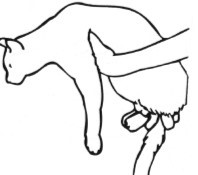
Holding a Cat: Once you have picked up your cat, you should position your cat in the holding position or safety carry.
Holding position and safety carry
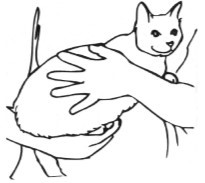 |
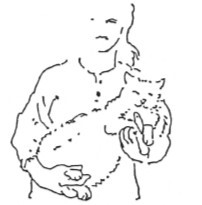 |
Showing a Cat’s Mouth, Teeth, and Gums: Have the cat face the judge. Show your cat’s mouth, teeth and gums as shown in either illustration.
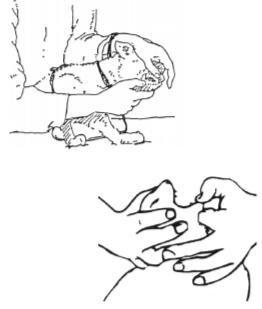
Showing a Cat’s Eyes: Have the cat face the judge. Show your cat’s eyes as shown in either illustration.
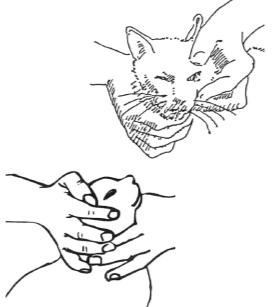
Showing a Cat’s Claws and Coat: To show the cat’s claws, slide your hand down over the cat’s shoulder and leg, grasp the paw and gently squeeze it to show the claws. Show the claws on all four paws. To show the cat’s coat, hold the cat on his/her rump with the belly facing the judge. Ruffle the coat to show cleanliness and grooming.
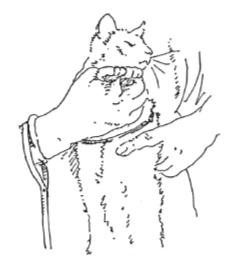
Showing the Cat’s Body Type:
long body short body
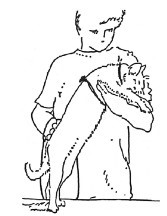 |
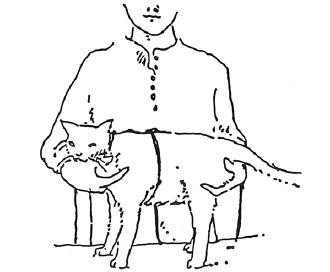 |
Showing a Cat’s Nose: Have the cat face the judge.
Showing a Cat’s Ears: Turn the cat so the judge can see the cat’s side view. Be sure the judge can see the cleanliness of the inside of the ear.
Showing the Cat’s Head Shape: Post the cat in a sitting or standing position facing the judge. Show conformation of your cat’s head.
Showing the Cat’s Tail and Coat Texture: Show your cat’s tail by grasping the top and showing its length. If your cat does not have a tail, show where the tail would be. The show coat texture, keep the cat with his/her side toward the judge, run your hand against the lay of the coat and then back down the body to make it smooth.
